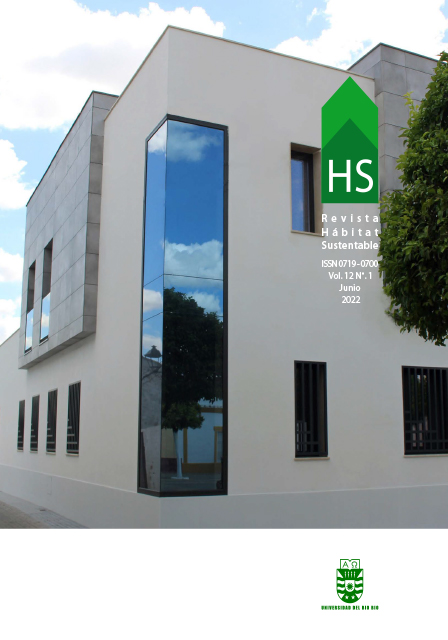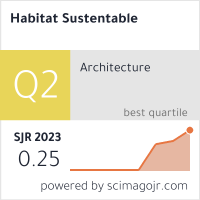Construcción con bloques de suelo cemento como alternativa sostenible para envolvente Edilicia
DOI:
https://doi.org/10.22320/07190700.2022.12.01.08Palabras clave:
ladrillos sustentables, termografía pasiva en viviendas, reducción de pérdidas de calor, conductividad térmica, resistencia térmica superficialResumen
Los materiales alternativos, como los bloques de suelo estabilizado con cemento (BSEC), brindan nuevas oportunidades para realizar envolventes amigables con el medio ambiente. Los materiales de construcción realizados con suelo son fáciles de obtener y abundantes en la naturaleza, además de que su uso minimiza los impactos ambientales y mejora el comportamiento térmico de las edificaciones. En este trabajo se analizan las propiedades térmicas de los BSEC con el objeto de evaluar la eficiencia de los bloques para la construcción de envolventes. Se determina, mediante ensayos experimentales, que los porcentajes de cemento deberían ubicarse entre 3% y 9% para la fabricación de BSEC adecuados para mamposterías no portantes. El contenido de humedad debería ser inferior al 20%, a fin de evitar aumentos significativos en la conductividad térmica. A través de termografía pasiva se define también la resistencia térmica de los muros y las resistencias superficial interior y exterior mediante. Las distintas composiciones de muros con BSEC de una vivienda experimental en condiciones reales de uso se monitorearon durante época invernal y, a partir de ello, se establecieron transmitancias térmicas para los muros desde 1,219 W/m2K a 1,599 W/m2K. Los resultados obtenidos permitieron determinar la eficiencia relativa de los distintos tipos de envolventes para evitar pérdidas de calor.
Descargas
Citas
AENOR (2008). Norma española UNE 41410. Bloques de Tierra Comprimida para Muros y Tabiques. Definiciones especificaciones y métodos de ensayo. Recuperado de https://www.une.org/encuentra-tu-norma/busca-tu-norma/norma?c=N0042285
ALLEN, G. T. R. (2012). Strength Properties of Stabilized Compressed Earth Blocks with Varying Soil Compositions. Tesis doctoral. University of Colorado.
BALAJI, N. C. y MANI, M. (2019). Error Analysis on Thermal Conductivity Measurements of Cement-stabilized Soil Blocks. Earthen Dwellings and Structures (pp. 333-343). Singapore: Springer. DOI: https://10.1007/978-981-13-5883-8_29
BALAJI, N. C., MANI, M. y VENKATARAMA REDDY, B. V. (2016). Thermal conductivity studies on cement-stabilised soil blocks. Proceedings of the Institution of Civil Engineers-Construction Materials, 70(1), 40-54. DOI: https://doi.org/10.1680/jcoma.15.00032
BORBÓN, A. C., CABANILLAS, R. E. y PÉREZ, J. B. (2010). Modelación y simulación de la transferencia de calor en muros de bloque de concreto hueco. Información tecnológica, 21(3), 27-38.DOI: 10.1612/inf.tecnol.4223it.09
COSTANTINI, A. B., CARRO PÉREZ, M. E. y FRANCISCA, F. M. (2016). Evaluación del comportamiento térmico de una edificación reemplazando el material de la envolvente por suelo-cemento. Avances en Energías Renovables y Medio Ambiente, 20, 33-43.
COSTANTINI, A. B., FRANCISCA, F. M. y GIOMI, I. (2021). Hygrothermal properties of soil-cement construction materials. Construction and building materials, 313, DOI: https://doi.org/10.1016/j.conbuildmat.2021.125518.
DAHMEN, J. y MUÑOZ, J. F. (2014). Earth masonry unit: sustainable CMU alternative. International Journal of GEOMATE, 6(2 SERL 12), 903-910.
DAMFEU, J. C., MEUKAM, P. y JANNOT, Y. (2016). Modeling and estimation of the thermal properties of clusters aggregates for construction materials: The case of clusters aggregates of lateritic soil, sand and pouzzolan. International Journal of Heat and Mass Transfer, 102, 407-416. DOI: https://doi.org/10.1016/j.ijheatmasstransfer.2016.06.044
DAO, K., OUEDRAOGO, M., MILLOGO, Y., AUBERT, J. E. y GOMINA, M. (2018). Thermal, hydric and mechanical behaviours of adobes stabilized with cement. Construction and Building Materials, 158, 84-96. DOI: 10.1016/j.conbuildmat.2017.10.001
FOX, M., COLEY, D., GOODHEW, S. y DE WILDE, P. (2014). Thermography methodologies for detecting energy related building defects. Renewable and Sustainable Energy Reviews, 40, 296-310. DOI: https://doi.org/10.1016/j.rser.2014.07.188
GRINZATO, E., VAVILOV, V. y KAUPPINEN, T. (1998). Quantitive infrared thermography in buildings. Energy and buildings, 29(1), 1-9. DOI: https://doi.org/10.1016/S0378-7788(97)00039-X
INTI (2005). Ahorro y certificación energética: la envolvente de los edificios. Saber cómo, (27), 4.
MOZEJKO, C. A. y FRANCISCA, F. M. (2020). Enhanced mechanical behavior of compacted clayey silts stabilized by reusing steel slag. Construction and Building Materials, 239. DOI: https://doi.org/10.1016/j.conbuildmat.2019.117901
MUÑOZ, N., THOMAS, L. P. y MARINO, B. M. (2015). Comportamiento térmico dinámico de muros típicos empleando el método de la admitancia. Energías Renovables y Medio Ambiente (ERMA), 36, 31-39.
NAGARAJ, H. B., SRAVAN, M. V., ARUN, T. G. y JAGADISH, K. S. (2014). Role of lime with cement in long-term strength of Compressed Stabilized Earth Blocks. International Journal of Sustainable Built Environment, 3(1), 54-61.
Norma IRAM Nº 11601, (1996). Aislamiento térmico de edificios. Propiedades térmicas de los materiales para la construcción. Método de cálculo de la resistencia térmica total. www.iram.org.ar.
OUEDRAOGO, K. A. J., AUBERT, J. E., TRIBOUT, C. y ESCADEILLAS, G. (2020). Is stabilization of earth bricks using low cement or lime contents relevant? Construction and Building Materials, 236. DOI: https://doi.org/10.1016/j.conbuildmat.2019.117578.
REVILLAS, S. M. (2011). Guía de la Termografía Infrarroja. Madrid: Asociación Española de Termografía Infrarroja.
REVUELTA, D., GARCÍA-CALVO, J. L., CARBALLOSA, P. y PEDROSA, F. (2021). Evaluation of the influence of the degree of saturation, measuring time and use of a conductive paste on the determination of thermal conductivity of normal and lightweight concrete using the hot-wire method. Materiales de Construcción, 71(344), e260-e260. DOI: https://doi.org/10.3989/mc.2021.03621
SEKHAR, D. C. y NAYAK, S. (2018). Utilization of granulated blast furnace slag and cement in the manufacture of compressed stabilized earth blocks. Construction and Building Materials, 166, 531-536. DOI: https://doi.org/10.1016/j.conbuildmat.2018.01.125
SHARLON, M. R. (2008). Active Thermography: An Overview of Methods and Their Applications in Use Today. Orlando, Florida.
SITTON, J. D., ZEINALI, Y., HEIDARIAN, W. H. y STORY, B. A. (2018). Effect of mix design on compressed earth block strength. Construction and Building Materials, 158, 124-131. https://doi.org/10.1016/j.conbuildmat.2017.10.005
United Nations Environment Programme [UNEP] (2009). Recuperado de https://www.unenvironment.org/resources/annual-report/unep-2009-annual-report
WILLIAMS C., GOODHEW S., GRIFFITHS R. y WATSON, L. (2010). The feasibility of earth block masonry for building sustainable walling in the United Kingdom. Journal of Building Appraisal, 6(2), 99-108.
YAGI S. y KUNII D., (1957) Studies on Effective Thermal Conductivity in Packed Bed AIChE Journal, 3(3), 373-381. DOI: https://doi.org/10.1002/aic.690030317
YUN, T. S. y SANTAMARINA, J. C. (2008). Fundamental study of thermal conduction in dry soils. Granular matter, 10(3). DOI: https://doi.org/10.1007/s10035-007-0051-5
Descargas
Publicado
Cómo citar
Número
Sección
Licencia
Derechos de autor 2022 Adriana Belen Costantini-Romero, Franco M. Francisca

Esta obra está bajo una licencia internacional Creative Commons Atribución-CompartirIgual 4.0.
El contenido de los artículos que se publican en cada número de Hábitat Sustentable, es responsabilidad exclusiva de los autores y no representan necesariamente el pensamiento ni comprometen la opinión de la Universidad del Bío-Bío.
Los autores/as conservarán sus derechos de autor y garantizarán a la revista el derecho de primera publicación de su obra, el cuál estará simultáneamente sujeto a la Licencia de Reconocimiento de Creative Commons CC BY-SA que permite a otros compartir-copiar, transformar o crear nuevo material a partir de esta obra con fines no comerciales, siempre y cuando se reconozcan la autoría y la primera publicación en esta revista, y sus nuevas creaciones estén bajo una licencia con los mismos términos.











 Programa de Información Científica/Concurso Fondos de Publicación de Revistas Científicas 2018/ Proyecto Mejoramiento de Visibilidad de Revistas UBB (Código:FP180007)
Programa de Información Científica/Concurso Fondos de Publicación de Revistas Científicas 2018/ Proyecto Mejoramiento de Visibilidad de Revistas UBB (Código:FP180007) 





